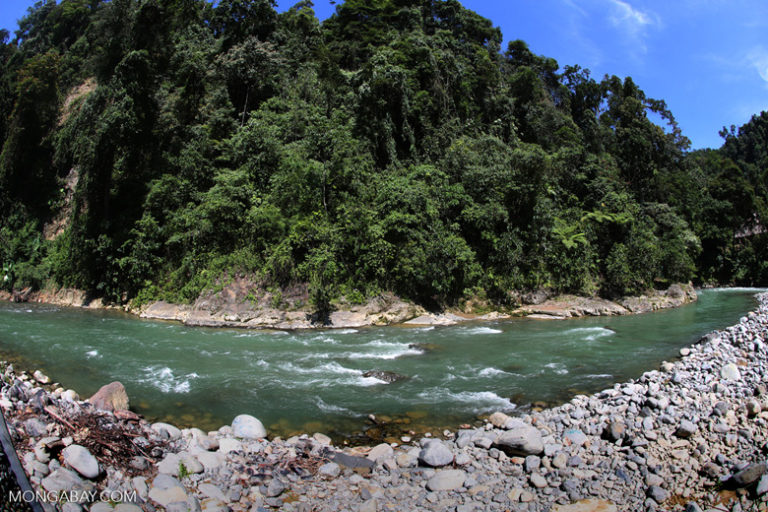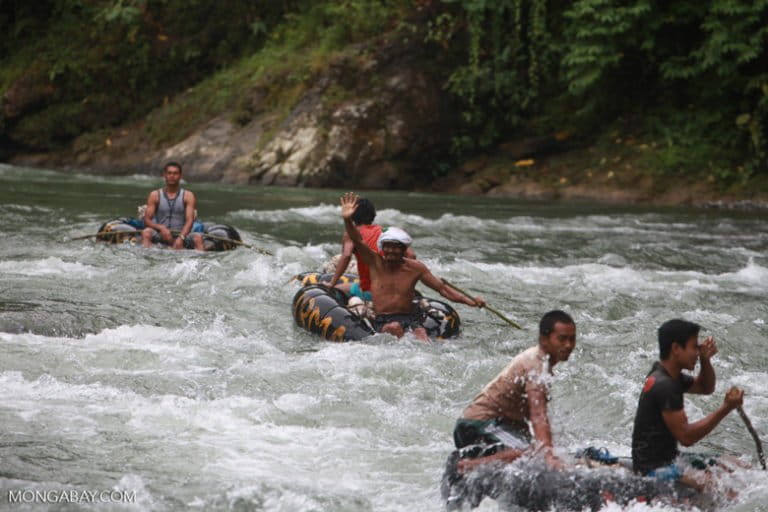- In the last two decades, conservation and the market economy merged into what is called “neoliberal conservation,” where economic growth and the protection of nature are thought to be essentially compatible.
- However, conservation in places like North Sumatra will be last on the agenda when markets tumble and the economic system that people are now addicted to – in even the most remote places – collapses.
- Schemes like ecotourism and payment for ecosystem services should be paired with programs like sustainable local agriculture to prevent the re-emergence of poaching and illegal logging, and to ensure that conservation-oriented behaviors persist when markets fail.
- This article is a commentary and does not necessarily reflect the views of Mongabay.
I am writing this from Bukit Lawang (North Sumatra, Indonesia) a prominent ecotourism town on the fringes of the Gunung Leuser National Park. The town is devoid of tourists amid the Covid-19 crisis and the high season is supposed to start soon. Many people are entirely reliant on tourists and you can sense the despair in the air as it is uncertain when planes will take off again and people will start traveling to distant places.
In the last two decades conservation and the market merged into what is now labelled by social scientists as “neoliberal conservation” (see for example Büscher et al. 2012). According to its proponents, nature can only be saved through merging conservation and capitalism, regarding ecosystems as capital and its subsequent revaluation in capitalist terms (McAfee 1999). McAfee suitably labeled this ‘‘selling nature to save it.’’
The main message of neoliberal conservation is that economic growth and the protection of nature are essentially compatible, instead of being mutually exclusive, disregarding that economic growth caused the depletion of ecosystems in the first place.

According to scholars (e.g. Büscher at al. 2012) and talking with fellow conservationists and project developers, market-oriented solutions and direct economic incentives seem by consensus as a solution and are now common practice. It is hoped that this merger bridges the gap between the conservation agenda and the interests of local resource-dependent communities, and dissent is rarely seen.
The idea is to give economic incentives to change livelihood generating practices that undermine conservation (e.g. hunting, land conversion, and logging) toward behaviors that are aligned with the ideas of conservationists. These incentives most commonly come through ecotourism and payment for ecosystem services for instance, for carbon storage and sequestration under REDD+.
Yet, we have to ask ourselves whether solely relying on markets to solve our conservation problems is the right way to go. Basically, we are disregarding that the market within our capitalist system created the problems we seek to address in the first place.
See related: Cash for conservation: Do payments for ecosystem services work?
The solutions to address the ecological crisis are increasingly framed towards market and technological innovation in ways that deflect away from the systemic causes of ecological and socio-economic crisis (see Büscher et al. 2012). Whether it is carbon credits, ecotourism, or other market-based conservation incentives, the main reasoning behind it is that nature should be protected in order to get financial benefits.

I also clearly documented this during my master’s thesis research in Cambodia, when analyzing the motivation behind local people engaged in conservation. The incentive was community-based ecotourism and their main motivation to stop poaching and illegal logging was to get money. There were no intrinsic values given to forest and wildlife, and when asked, respondents most of the time stated that the forest and wild animals are important for the tourists (and this is in a traditionally Buddhist society).
Though these types of economic incentive driven projects may bring a change in behavior, they usually only value nature as a commodity that brings money. Before people hunted animals and logged trees to supply the illicit wildlife and timber trade, and now, they preserve it because it attracts paying tourists.
In short: nature has to be profitable and be utilized in order to be conserved. However, what happens when economies break down due to an international crisis as we are witnessing right now with Covid-19? The economic incentive for conservation falls away and if people cannot meet their imminent livelihood needs, and there is no intrinsic value associated with conservation, then the motivation to keep up conservation is gone.
During my research in Cambodia in 2018, I contemplated this scenario, and when respondents were asked what they would do if tourists stopped coming, most could not grasp this thought, or said they would have no other choice but to revert to the old ways in order to survive, through poaching and logging. In addition, food security was undermined, as people became less self-sufficient once shifting cultivation practices stopped to fit the conservation ideology, sourcing most of their rice from outside the community.

Moving forward, we need to invest in socio-ecological resilience among stakeholder communities. If we promote conditions where local people are completely dependent on external market forces, and the motivation behind conservation is money-based, then conservation will always be dependent on a stable global economy, which is highly uncertain as we are witnessing right now.
What we need is to bolster and secure localized sustainable production of food, which has traditionally been the case. The community should be able to meet most of their dietary requirements from within the landscape. Further, we have to promote and strengthen environmental stewardship, which includes reviving traditional practices and cultural values that give intrinsic importance to nature by internalizing the connectedness between wellbeing and ecosystem health.
See related: Agroforestry supports food security and conservation in Papua New Guinea
Market-based incentives can be used as an add-on tool to smooth the transition towards conservation-oriented behaviors, yet the basis has to be sustainable local agriculture as well as an intrinsic value associated with nature.
If a monetary-based value system is the reason why humans conserve nature, and markets determine what to protect, for what reasons, and for how much, then conservation will be last on the agenda when markets tumble and the economic system that people are now addicted to – in even the most remote places – collapses.
Sinan Serhadli is an adviser on conservation and livelihood development programs across Southeast Asia for the People Resources and Conservation Foundation.
Citation: Bram Büscher, Sian Sullivan, Katja Neves, Jim Igoe & Dan Brockington (2012) Towards a Synthesized Critique of Neoliberal Biodiversity Conservation, Capitalism Nature Socialism, 23:2, 4-30, https://doi.org/10.1080/10455752.2012.674149
Banner image: large male orangutan in Sumatra, photo by Rhett A. Butler for Mongabay.
View Mongabay’s special series, Conservation Effectiveness, which examines the efficacy of major conservation methods in use today, here.
